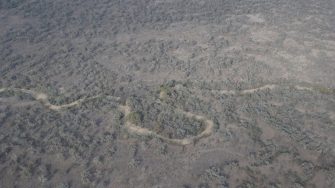
Date: Wednesday, November 15, 2017
Project: Eastern Australian Waterbird Survey
Last day of the 2017 survey – there was a pep in our step today. No more crack of dawn rises and late nights transcribing data after today. I spent last night checking out all the satellite imagery for the western lakes, including Narran Lakes, Yantabulla Swamp and Currawinya Lakes on the Paroo. They were all dry, confirmed by a phone call to Queensland environment agency, charged with managing Currawinya National Park on the Paroo River, north of Hungerford. We decided we still needed to survey Narran as there was a green tinge on the satellite imagery which can sometimes indicate flooding. There was clearly not much water if any.
First, out west along the Gwydir and Gingham watercourses to finish our second count, past all the upstream cotton irrigation west of Moree which uses much of the water that once flooded the extensive Gwydir system.
One of the large dams or off-river storages which are used to hold water pumped from the Gwydir River to grow cotton during the summer.
Surveying the magnificent remaining wetlands of the Gwydir River system
Once we had finished doing our second counts on the Gwydir, we headed northwest to the Narran Lakes System. This is supplied by the Condamine-Balonne River system which has had considerable development in last few decades which has severely compromised the long-term ecological integrity of the Narran Lakes system – a Ramsar-listed wetland.
The Narran River snakes its way with water in its main channel down to Narran Lakes system but the volume of water was so small that it made no impression on flooding of this system. No flooding and no waterbirds anywhere up here.
Small arteries of green across Clear Lake, part of Narran Lake Nature Reserve, show where the water was last to dry on the lake bed.
We then refuelled at Walgett before heading south to the Macquarie Marshes. A small environmental flow showed once again how magnificent this wetland can be when there was water. Our job was to fly 11 systematic surveys east to west, across the Marshes, to get an estimate of the total counts of waterbirds. During these surveys, we diverted to make sure there were no herons, egrets, cormorants or the three ibis species breeding in their known colony sites.
Surveying one of the known egret colonies on the Macquarie Marshes
There were no breeding waterbirds this year, a big contrast to last year. There was a wonderful response last year with tens of thousands of waterbirds breeding in the Marshes. Not this year. Still - wherever there was water, there were waterbirds.
One of the productive lagoons with large numbers of pelicans and yellow-billed spoonbills.
As we worked south, the contrast between dryland and wetland became greater. The transformation of this landscape with water is incredible.
Tracking the effect of an environmental flow on the Macquarie Marshes
Even though this wasn’t a big flood and there was no breeding, there was a moderate number and diversity of waterbirds. Given the size of this wetland, it underscores once again its environmental importance.
We finished by lunch time – the 35th year of our survey done. Once again a very important set of data for telling the stories of waterbirds, wetlands and rivers across about a third of the continent.
